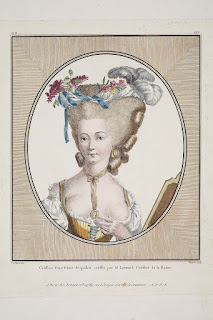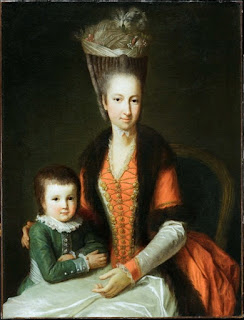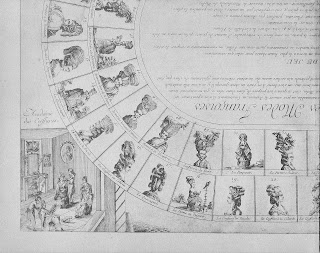 |
| Leonard przy pracy/ Monsieur Leonard at work, "Galerie des modes francaises et angloise", 1778 - 1787, Bunka Gakuen Library |
 |
| Coëffure d’une Dame de qualité coëffée par M. Leonard Coëffeur de la Reine., Gallerie des Modes ..., 1781, Boston MFA |
Unusual hairstyles and creative ingenuity earned him popularity especially among the ladies of the aristocracy. His clients had already begun to be of Madame du Barry, Marquise de Langeac and from 1772 years also Marie Antoinette.
 |
| Kostium sceniczny Wenus/ Costume of Venus, Galeire des modes ... Bunka Gakuen Library |
Na dworze francuskim Leonard spotkał Rose Bertin, z którą przez wiele lat współpracował. Razem z nią przy finansowej pomocy Marii Antoniny uzestniczył w edycjach żurnala o modzie Journal des Dames ukazujący się w latach 1759 - 1775. Żurnal ten był "tubą propagandową" mody dworskiej i prezentował ubiory zarówno Rose jak i Leonarda.
On the French court Leonard met Rose Bertin, which for many years worked. Together with her with the financial help of Marie Antoinette participated in the editions being fashionable fashion Journal des Dames appearing in the years 1759 - 1775. Magazine was "propaganda" courtly fashion and clothing presented both Rose and Leonard.
 |
| Journal des Dames, 1775, BNF |
Rose was famous for the most popular hairstyle known as Quesaco (what is?). It was a highly pinned hair with curls and the back had three large white ostrich feathers. This name is said to have given himself Auguste de Beaumarchais, who at the sight of oddities began to laugh and ask What's this ?
However, the story of this writing, the fact is that this haircut survived until the 90s the eighteenth century, becoming the determinant elegance of women from that period. It is, however, conjecture or indeed Rose Bertin was the creator of this hairstyle was not yet a trained hairdresser and milliner, how much of it was invention creative Leonard, sources silent.
Leonard z kolei był twórcą znanych pouf aux sentiment. Czepek sentymentalny wymagał wysokiej fyrzury upiętej na wypychaczach z włosia końskiego czy waty wełnianej, na której upinano delikatne tkaniny (Leonard potrzebował ok. 14 metrów), dodając do nich treski z loków. Pouf był modelowany w zalezności od kaprysu modelki - zależał też od danego tematu, ozdobiano go diamentami, sztucznymi kwiatami, owocami, warzywami, wypchanymi ptakami czy małymi miniaturowymi laleczkami i miniaturowymi portecikami osób z rodziny - dlatego też nazywano je aux sentimentale. Pierwszą damą dworu dla której Leonard wykonał pouf była księżna de Chartres, na jej fryzurze znajdowała sie postac kobiety z dzieckiem, papugi księżnej oraz ulubionego czarnoskórego służącego.
Z czasem czepki te wyszły z domy na dworze ale stały się popularne w innych europejskich krajach. Mieszczanki nie zawsze nosiły tego typu fryzury chociaż zgodnie z ówczesnymi trendami czepki mieszczańskie także nabrały dużych rozmiarów.
Leonard, in turn, was the creator of famous pouf aux sentiment. These pouf require high hairdress decorated which delicate fabrics as gauze (Leonard needed approx. 14 meters), adding to their hairpieces with curls. Pouf was modeled on a whim depending on the model - depended also on the topic, adorn it with diamonds, artificial flowers, fruits, vegetables, stuffed birds or small miniature dolls and miniature of the family - why they were called aux sentimentale. The first lady of the manor for which Leonard made a pouf was the Duchess de Chartres, her hairstyle was the figure of a woman with a child, parrots and Duchess of favorite black servant.
Over time, these caps came out of the houses on the outside but have become popular in other European countries. Burgeoirs woman not always wore this type of hairstyle although according to contemporary trends of caps also gained large.
| D. Chodowiecki, Coeffures de Paris, Genealogishen Kalender auf das 1780 Jahr, Lauenburg |
Moda nabierała rozmachu damy nosiły ogrody, rzeczki i lasy całe krajobrazy i parki, francuska namietność do wojny amerykańskiej oraz bitwy francuskie to wszystko mogło stanowić o inspiracji fryzur.
Wielki sukces Leonarda umożliwił mu założenie Académie de coiffeur. Była to zarówno szkoła jak studio gdzie mistrz nazywany już jako Monsieur Leonard czesał damy podług własnych inspiracji. Warto wspomnieć, że Leonard ściągnął do Paryża swoich młodszych braci, którzy także wyszkolili się w tym samym zawodzie. Pierre pracował dla siostry króla Ludwika XVI madame Elisabeth a Jean - Francois także dla Marii Antoniny i jej dworu. Oboje bracia wykorzystywali sławę starszego brata i nazywali się jako Monsiuer Leonard co później stworzyło problem dla badaczy zajmujących się jego biografią.
| D. Chodowiecki, Coeffures de Dresde, Genealogishen ... 1780, Lauenburg |
Fashion in these times was greate and famous, ladies wore gardens, rivers and forests and landscapes and parks, the French passion for war, American and French battle all this could be the inspired hairstyles.
The great success of Leonardo enabled him to assume the Académie de coiffeur. It was both a school as the studio where the master called already as Monsieur Leonard worked with ladies client with own inspiration. It is worth mentioning that Leonard brought to Paris, his younger brothers, who are also trained in the same profession. Pierre worked for the sister of King Louis XVI, Madame Elisabeth and Jean - Francois also for Marie Antoinette and her court. Both brothers used the fame and older brother called as Monsiuer Leonard which later created a problem for researchers dealing with his biography.
W latach 80. XVIII wieku Leonard stał sie bogatym człowiekiem i nie musiał już tak intensywnie pracować. Nadal był nadworny fryzjerem królowej (Coiffeur de la Reine) przygotowując fryzury na uroczystości i bale ale coraz mniej się angażował w pracę pozostawiając ją pod opieką swoich braci.
In the 80 years of the eighteenth century, Leonard became a rich man and did not have to work so hard. He was still the queen's court hairdresser (Coiffeur de la Reine) preparing hairstyles for parties and balls.
 |
| Armida, Glucka, rys. anonimowy/ anonimous drawing, set design from Armide, Gluck |
Drugą pasją Leonarda Autie był teatr i opera włoska. Z namową Marii Antoniny Leonard został impresariem i założył swój własny po wielu perypetiach nazwany Theatre de Monsieur. Impresario miał ambitne plany prezentować na deskach teatru operę włoską, francuską, sztukę francuską i francuskie wodewile (vaudevilles à caractères). Teatr został otwarty w 1789 roku w styczniu i zakładał roczną działalność. Niestety scena ta nie przetrwała ze względu na rewolucyjną zawieruchę.
Mało jest informacji o tym co się działo z Leonardem podczas rewolucji we Francji. Wiadomo, że jego brat Jean Francois towrzyszył księciu de Choiseul podczas nieforunnej ucieczki króla do Varennes, został złapany i stracony na gilotynie w 1794 roku.
Leonard Autie other passion was the theater and the Italian opera. On the insistence of Marie Antoinette Leonard was impresario and founded his own after many vicissitudes called the Theatre de Monsieur. Impresario had ambitious plans to present on stage Italian opera, French, French art and the French vaudeville (vaudevilles a Caractères). The theater was opened in 1789 in January and assumed an annual activity. Unfortunately, this scene did not survive because of the revolutionary turmoil.
There is little information about what happened to Leonard during the Revolution in France. It is known that his brother Jean Francois accompanied the Duke de Choiseul during unfortunately escape the king to Varennes, was captured and executed on the guillotine in 1794.
 |
| A. Gore, Portret Teofili Sapiechy z Jabłonowskich, 1775, Wawel, Portratit of Teofila Sapiecha Jabłonowska a Polish magnate lady, 1775 |
Leonard uciekał z Francji po arsztowaniu rodziny królewskiej, nie jest jasne gdzie przebywał, istnieją przekazy jakoby uciekł do Rosji. Do Francji wrócił w 1814 roku, zmarł w 1820.
Leonard ożenił się w 1779 roku i miał 3 córki i jednego syna, nie pozostawił testamentu, nie wiadomo czy zachował majątek czy też go stracił podczas rewolucji. Jedyną pozostałością po splendorach królewskiego fryzjera zaświadczała broszka z feniksem prawdopodobny prezent od Marii Antoniny.
Leonard miał pozostawić po sobie wspomnienia ale badaczekwestionują ich autentyczność.
Souvenirs de Léonard, coiffeur de la reine Marie-Antoinette wydane zostały pośmiertnie w 1833 przez Alphonse Levavasseur'a. Mimo tego ci sami badacze powołują się na te wspomnienia. Levavasseur miał otrzymać luźne karty zapisanych wspomnień i sam dokonywać odpowiedniej korekty.
 |
| Quesaquo, J. Faworski, Portret młodej kobiety, datowanie moje 1789/ Polish painting of Jóżef Faworski, Polish young lady with Leonardo's Quesaquo. |
Leonard fled from France after aresting royal family, it is not clear where he was staying, there are messages allegedly fled to Russia. He returned to France in 1814, died in 1820.
Leonard got married in 1779 and had three daughters and one son, no will, it is not known whether the retained property or lost it during the revolution. The only remnant of the Royal Coiffeur testified splendorach brooch with phoenix likely a gift from Marie Antoinette.
Leonard had to leave behind memories but researches are not sure their authenticity.
Souvenirs de Léonard, coiffeur de la reine Marie-Antoinette were published posthumously in 1833 by Alphonse Levavasseur. Despite this, these same researchers refer to these memories. Levavasseur was to receive loose cards stored memories and himself to make appropriate adjustments.
 |
| F. Garsault, L'Art du Perruquieur, Paris, 1769 BNF |
 |
| Duchesse de Chartres, 1778 |


2 komentarze:
This is how my partner Wesley Virgin's report starts in this shocking and controversial video.
Wesley was in the army-and shortly after leaving-he unveiled hidden, "mind control" tactics that the government and others used to obtain everything they want.
THESE are the EXACT same secrets many celebrities (notably those who "became famous out of nowhere") and the greatest business people used to become wealthy and successful.
You probably know that you use less than 10% of your brain.
Really, that's because the majority of your brainpower is UNCONSCIOUS.
Perhaps that conversation has even taken place INSIDE OF YOUR own mind... as it did in my good friend Wesley Virgin's mind seven years ago, while driving an unregistered, beat-up garbage bucket of a car with a suspended license and with $3.20 on his bank card.
"I'm so fed up with going through life paycheck to paycheck! When will I get my big break?"
You took part in those conversations, isn't it right?
Your own success story is waiting to be written. All you need is to believe in YOURSELF.
UNLOCK YOUR SECRET BRAINPOWER
Prześlij komentarz